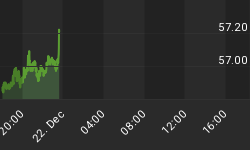The U.S. Mint just reported another record, but this time it wasn't for gold. The Mint sold more Silver Eagles in March and in the first quarter of the year than ever before. A total of 9,023,500 American Silver Eagles were purchased in Q110, the highest amount since the coin debuted in 1986.
While this is certainly bullish, there's something potentially more potent developing in the background. Namely, how this matches up with U.S. silver production. Like gold, the U.S. Mint only manufactures Eagles from domestic production. And U.S. mine production for silver is about 40 million ounces. In other words, we just reached the point where virtually all U.S. silver production is going toward the manufacturing of Silver Eagles.
Yikes.
This is especially explosive when you consider that roughly 40% of all silver is used for industrial applications, 30% for jewelry, 20% for photography and other uses, and only 5% or so for coins and medals.
To be sure, mine production is not the only source of silver. In 2009, approximately 52.9 million ounces were recovered from various sources of scrap. Further, the U.S. imported a net of about 112.5 million ounces last year. (Dependence on foreign oil? How about dependence on foreign silver!) So it's not like there's a worry there won't be enough silver to produce the Eagle you want next month.
Still, why so much buying? The silver price ended the quarter up 15.5% from its February 4 low - but it was basically flat for the quarter, up a measly 1.9%. We tend to see buyers clamoring for product when the price takes off, so the jump in demand wasn't due to screaming headlines about soaring prices.
I have a theory.
For some time, silver has been known as the "poor man's gold." Meaning, silver demand tends to increase when gold gets too "expensive." The gold price has stubbornly stayed above $1,000 for over six months now and spent much of that time above $1,100. You'd be lucky to pay less than $1,200 right now for a one-ounce coin (after premiums), an amount most workers can't pluck out of their back pocket. But Joe Sixpack just might grab a "twelve-pack" of silver.
What would perhaps lend evidence to my theory is if gold sales were down in the face of these higher silver sales.
The U.S. Mint reported a decline in gold bullion sales of 20.8% this past quarter vs. the same quarter in 2009. Further, other world mints have seen sharp declines in gold bullion coin sales as well: the Austrian Mint reported an 80% drop in sales for the first two months of the year and the Royal British Mint a 50% decline in gold coin production for the first quarter.
What's even more dramatic is the difference in the dollar value of the sales. Gold Eagle sales in the U.S. dropped $10,263,500 from a year earlier - but silver sales increased by $61,855,290. So, not only did silver sales make up the drop in gold sales, they exceeded them by $51,591,790.
Is the rush into "poor man's gold" underway?
Why the answer to that question is significant is that a shift toward silver for this reason could signal we're inching closer to the greater masses getting involved in the precious metals arena. And that - for those of us who've been invested for awhile now - would be music to the ears. Because when they start getting involved, the mania will be underway, and from that point forward, it's game on.
I'm not saying the mania is starting, and I actually think we could see another sell-off before things take off for good. Gold could dip to $1,000 and maybe even $950, with silver going to the $14-$15 range. But as clues like these begin to build up, we'll know we're getting closer. (And any drop to those ranges would clearly be a major buying opportunity.)
Everyone talks about gold, myself included, but a meaningful portion of one's precious metals portfolio should be devoted to silver. The market is tiny, making the price potentially explosive. Remember that in the '70s bull market gold advanced over 700%, but silver soared over 1,400%.
Don't be a "poor man" by ignoring gold's shiny cousin.
While buying silver is a must, it's the silver stocks that will truly soar in a mania. And I'm convinced we recommend the two best silver producers in the world. Get their names and our suggested entry points with a risk free trial to Casey's Gold & Resource Report... click here.















